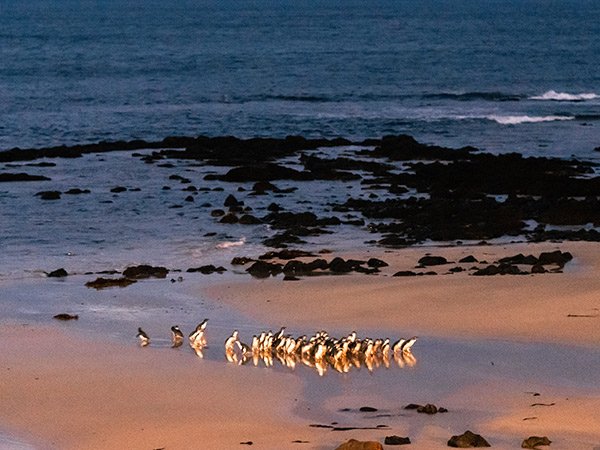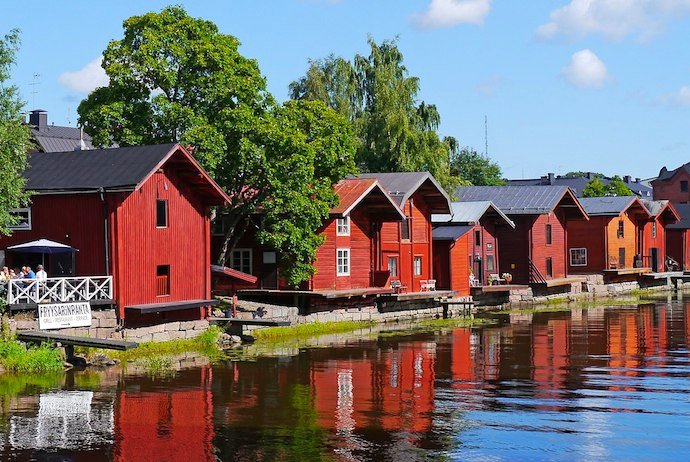From tomato beer to tectonic plates, is this the best day trip from Reykjavik?
Our guide Regina talks a million miles an hour as our coach rumbles out of Reykjavik towards Iceland’s Golden Circle. It feels like the dead of night, but it’s 9 am in mid-November and the moon is still high in the sky. We need coffee. Lots of coffee. Luckily we booked a hotel with a decent breakfast (very important in expensive Iceland), so we’ve filled our thermos flasks for free.
Alternating between English, German and Icelandic as the snow flutters down outside, Regina tells us what’s in store for us today in Iceland’s Golden Circle – the country’s most famous attraction. We’ve booked a day trip from Reykjavik, which takes us through Thingvellir National Park, to the famous Gullfoss waterfall, and to Strokkur, Iceland’s most visited active geyser.
Regina tells us about a hot spring that developed under someone’s house as we wind our way through the area where “they’re waiting for the big one.” Soaking in the snow-covered lava fields surrounding us, we hope it doesn’t happen today. Not that there’s a preferable day for being engulfed by bubbling lava.
TOP TIP: Take your phone cables for the coach. Most coaches in Iceland have USB ports on the seats, which is something even your airplane won’t have on the way over!
Sipping our coffee, we’re wowed by how Iceland’s Golden Circle reveals even more majesty around every corner. We learn how the Vikings from Norway actually got stuck on this 16-million-year-old island by accident, after realizing there was no new timber to fix their deteriorating ships!
We pass sweeping fields of grazing or galloping horses, and salmon rivers where fishing is only permitted in summer. Regina tells us Eric Clapton came fishing here every summer for years, and bought three rods, which cost him over $20,000 per day. Either he really likes fishing, or this is some seriously good salmon.

Time for tomato beer at Friðheimar Greenhouse
Hand on heart, I’ve never been so impressed by a greenhouse – our first stop in Iceland’s Golden Circle. The snow’s coming down thick and fast outside now, but inside Friðheimar Greenhouse we find a warm, green oasis, made even better by a bar! But the bar is just a bonus.
Tomatoes have been growing in Friðheimar Greenhouse all year round since 1946. A whole family runs the business now, producing 700 tons of tomatoes annually across 11,000 square meters of electrically lit greenhouses. That accounts for 39% of Iceland’s tomato market, and it also means the fruit is harvested every single day.
Iceland’s rich natural resources are everything. Water used for irrigation comes from the exact same source as the drinking water. Quality is key to that tangy taste!
We also learn that there’s a weather station on the Friðheimar Greenhouse roof, which monitors wind speed and direction, temperature, and sunlight. It’s all connected to a computer system that can be accessed from anywhere. So, even if the owners are away in Hawaii, they can still make sure their juicy little tomato babies are thriving.
There are thousands of workers in Friðheimar Greenhouse
But not the kind you might think. Bumblebees are imported from Holland in little hives with their queen. They buzz about here freely, pollinating the tomato plants. Roughly 1,200 bees work around the clock at Friðheimar Greenhouse, and each stripy savior can visit up to 2,000 flowers a day.
There are no pesticides at Friðheimar Greenhouse either. Biological control – like the mirid bug, also imported from Holland – works wonders against pests. This little star chows down on just about all the other insects that might otherwise cause issues in Icelandic greenhouses.
Which brew will you choose?
We’re here before lunch, but we’re not about to turn down a mid-morning tomato beer.
There are two brews served at Friðheimar Greenhouse’s bar, brewed from red or green tomatoes, as well as some pretty good Bloody Marys. If you really want to make the most of those flavors, help yourself to some of the homegrown basil that’s sprouting from pots around the place. It’s next-level beer drinking. Luckily we only have about 45-minutes in here – there’s more of Iceland’s Golden Circle to see – so we can only manage two.
TOP TIP: Don’t forget to pick up a pot of freshly-picked tomatoes on the way out. They’re perfect to eat on the coach on the way to the next stop. And they’re probably the best tomatoes you’ll ever taste in your life!
Back on the bus, German-born Regina tells us she’s been in the land of fire and ice for 40 years. This adventure-seeking 50-something star has been leading groups through Iceland’s Golden Circle and beyond since 2010.
You’d think she’d be itching to do something different, but she insists she’s not. It’s a power position – showing people Iceland for the first time. “There’s no other place like it. I get all excited when my guests are excited,” she says, ushering our group back onto the bus and dutifully checking everyone off on her clipboard.
Watch out for eruptions
On the way to Gullfoss waterfall, we pass summer houses that run on geothermal energy, and the island’s first geothermal power plant. Regina tells us the legends and truths about Hekla and Katla – the two most revered and feared volcanoes in Iceland.
If she erupted, she says, Katla’s lava-wrath would claim the mountainside within one hour. Hekla is overdue an eruption apparently, “She’s 12 months pregnant and very cranky.”
FUN FACT: During the Middle Ages, Europeans called the volcano the Gateway to Hell, and in fact, the phrase “What the heck” came from Hekla herself!

A steamy walk around Strokkur
With Gullfoss waterfall just minutes away, we stop for a snowy walk around the steamy Strokkur geyser, a must-see on any of Iceland’s Golden Circle tours. Strokkur is a fountain geyser, first mentioned in 1789, before any other geysers in the world were discovered.
It’s a chilly walk, and we’re glad for the dregs in our flasks, but we almost spit them out in shock – not because of the eruption, which sends a spout of steaming water 20 meters into the air – but because of the scream. Strokkur blows its top every 4-8 minutes, and there’s always someone who screams when it happens.
We take pictures in what’s probably the snowiest spot so far in the Golden Circle – Iceland looks a lot like Narnia here. We wander around the fumaroles, hot springs, and bubbling mud pits and spot other smaller geysers ringed with colors. Sulfur (yellow), copper (green) and iron (red) look eerie in the snow.
A gorgeous gorge and Gullfoss waterfall
After some typical Icelandic lunch in the sprawling cafe/restaurant at Strokkur, and a wistful sigh over some luxury woolen jumpers in the gift shop (fine if you have over €250 to spend on a jumper!) we make our way to Gullfoss waterfall.
By now, we’re excited for the number one spot for photos in Iceland’s Golden Circle. It’s just a shame that on this occasion it’s snowing so hard we can hardly see it. We can definitely hear it though. It’s not quite cold enough yet for Gullfoss waterfall to have frozen into waves of glistening ice, and it roars through the wintry abyss of the canyon, deafening us.

Gullfoss waterfall cascades in two stages – one is 11 m (36 ft) high, and the other is 21 m (69 ft). Its waters wind up in a crevasse that was created at the end of the Ice Age by catastrophic flood waves! When the fog and spray finally clears, we witness it in all its gushing glory.
Gullfoss is declared property of the people
We’re told we can view this magnificent ‘property of the people of Iceland’ from two different levels. One involves more stairs than the other, so we stick to the easiest one, then run quickly back inside before our toes freeze off.
Back to the property of the people thing. There was talk of building a hydroelectric power plant around Gullfoss waterfall in the early 20th century. In the end, the foreign investors, who rented Gullfoss indirectly from the owners, were overpowered by concerned Icelanders who fought to keep it just the way it is. Magical!
I’d love to come back to Gullfoss waterfall in summer, when it’s warmer, and when thousands of rainbows are said to appear in the spray – courtesy of the elves, who got to keep it as their playground.
TOP TIP: Bring cash to tip your guides. Most places in Iceland now accept card payments, so people don’t carry cash. Your guide will be grateful for pounds, dollars, euros, or anything you want to bring.
The seat of Viking government: Thingvellir National Park
In spite of the snow, our last stop in Thingvellir National Park is probably the most exciting.
Thingvellir is the only place the Eurasian and North American tectonic plates can be seen meeting up on dry land. As we walk inside the rift, it’s quite bizarre to know the towering black stone cliffs on either side of us are actually the edges of continental plates.
The mountains creep through the snow clouds behind us as Regina helps us picture Thingvellir National Park in the 8th century AD.

Each summer, the Viking chieftains would travel from far and wide to congregate here, pass new laws, and judge court cases.
We could almost picture them here in their horned helmets, setting up temporary turf huts and hanging around for two weeks at a time; right up until 1262, when the country fell under Norwegian rule. I bet they had a party or two with some delicious puffin hors d’oeuvres and plenty of mead.
Conclusion
By the time we arrive back in Reykjavik, we have about a thousand new photos of the Golden Circle’s highlights in our phones, and a head full of Vikings and vining tomatoes. There are so many day trips from Reykjavik to choose from, but Regina, the snow, the spewing geysir, the tomato beer… all of it makes it a must-do for anyone looking to make the most of Iceland without a car.
Get tickets for Golden Circle & Friðheimar Greenhouse: Roundtrip from Reykjavik tour

